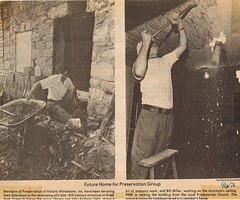Last week, we recapped the educational work of PHW through 1979. Similarly, the Revolving Fund Steering Committee had made great strides in purchasing and reselling endangered properties in this period. Twenty-two properties had been bought and “revolved” by the fund into the hands of new owners and helped stabilize the Potato Hill neighborhood. The story of their preservation generated less controversy than the efforts to save the Simon Lauck house, but they are worth noting nonetheless. Those properties included:
 1. 311 S. Loudoun St., The Simon Lauck House, c. 1790
1. 311 S. Loudoun St., The Simon Lauck House, c. 1790
Log house renovated into a quality office building.
2. 522 S. Loudoun St., Dr. Cornelius Baldwin’s House, c. 1785,
524 S. Loudoun St., Dr. Baldwin’s Doctor’s Office, c. 1800
Federal-style frame buildings restored as single family homes.
3. 510 S. Loudoun St., c. 1795 and
4. 512 S. Loudoun St., Grim-Moore Properties, c. 1780
Federal-style brick and log home renovated into a single family residence.
5. 20-22 S. Kent St. and
6. 24 S. Kent St., Grant Family Properties, c. 1883
Two frame townhouses renovated into commercial space and law offices.
 7. 121-127 W. Boscawen St., Josiah Massie’s Hatter Shop, c. 1810
7. 121-127 W. Boscawen St., Josiah Massie’s Hatter Shop, c. 1810
Log building renovated into owner-occupied office space.
8. 501 S. Loudoun St., c. 1800
Log house renovated into a single family residence.
9. 513 S. Loudoun St., c. 1800
Log and clapboard building renovated into a single family residence.
10. 702 S. Loudoun St., Andrew Baker House, c. 1800
Log and clapboard building, renovated into a single family residence.
11. 502 S. Loudoun St., c. 1882
Folk Victorian frame house, renovated into owner occupied residence with rental unit.
 12. 418 N. Loudoun St., Magill-Keller House, c. 1840 with 1880s Victorian additions
12. 418 N. Loudoun St., Magill-Keller House, c. 1840 with 1880s Victorian additions
Renovated into ten quality apartments.
13. 302 S. Kent St. and
14. 304 S. Kent St., Stoney Point, c. 1810
Log duplex built for the Everly family, renovated into two single family residences.
15. 606 S. Loudoun St., c. 1906
Frame workingman’s house sold to the tenant who renovated the house to be used as a single family residence.
16. 610 S. Loudoun St. and
17. 612-614 S. Loudoun St., Conrad Creb Properties, c. 1785
Log and clapboard houses, renovated into two single family residences.
 18. 115-119 S. East Lane, Robert Rose House, c. 1840
18. 115-119 S. East Lane, Robert Rose House, c. 1840
Brick Federal-style townhouse, renovated into a single family residence.
19. 211 S. Kent St., c. 1810
Log and frame house, renovated and maintained as a single family residence.
20. 219 S. Kent St., c. 1800
Log and German siding house, renovated as a single family residence.
21. 124 E. Clifford St., Joseph and Irene Virginia Hodgson House, c. 1913
Frame and stucco house preserved as a single family residence.
22. 125 E. Clifford St., c. 1840 with substantial improvements c. 1880
Log and frame house with Victorian additions. Renovated as a single family residence.
Additional images of Revolving Fund properties may be viewed in the Flickr album. For information on deed restrictions for Revolving Fund properties, please see the Jennings Revolving Fund page.





















